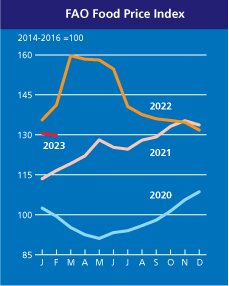World leader in global business intelligence, the Economist Intelligence
Unit (EIU) in its Global Food Security Index (GFSI) annual update,Expo Milan
2015, revealed that two-thirds of 109 countries have improved in food security,
reportsNaijaAgroNet.
The GFSI overall
results, NaijaAgroNet gathered was unveiled
at the DuPoint Forum on Food and Agriculture tagged; Rural and Urban
Innovations, showed that sustained economic expansion in
most regions and rapid growth in developing countries, especially in
Sub-Saharan Africa, combined with lower global food prices provided the
necessary food security improvement in almost every region of the world over
the past year.
It further revealed that food security
in Sub-Saharan Africa (SSA)improved in 28 countries in the region, with 82
percent recorded score increases between 2014 and 2015, and the region as a
whole saw a score improvement of 1.5 points.
Also it pointed out that Sub-Saharan
Africa saw impressive gains in food Quality & Safety, with Burkina Faso and
Mali leading the way, driven by improved access to quality protein, a measure
of the average consumption of essential amino acids in a country’s diet.
Burkina Faso also made significant strides in the diet diversification
indicator, with a 25% increase (87% score increase) in the amount of
non-starchy foods consumed in the average diet.
Dr Richard Okine,Regional Director
for DuPont Sub-Saharan Africa, speaking on the report said that,“Developing
countries often lack basic infrastructure, including storage, road and port
facilities, while smaller incomes inhibit access to and affordability of
nutritious food. Political risk and corruption frequently compound structural difficulties
in these countries. Investment in infrastructure and food systems in low-income
and lower-middle income countries is the key to narrowing the gap.”
He also stressed that an
overwhelmingly positive factor has been the fact that over the past few years,
the overall economic growth in the developing world has led to improvements in
the structural areas that are essential to improving people’s access to a wider
range of affordable, nutritious foods.
“This, according to Dr. Okine, includes
more extensive food safety-net programmes, expanded crop storage capacity and
dietary diversity.”
With such progress notwithstanding,
global food insecurity remains a challenge. According to UN estimates,NaijaAgroNet learnt that the world population is projected to increase
by 1 billion over the next 12 years and reach 9.6 billion by 2050, with growth
coming mainly from developing countries, with more than half in Africa. As populations’
boom and incomes rise in developing countries, the FAO also estimates that food
production will have to grow by 50% to meet demand.
The GFSI is an annual measure of
food security across 109 countries, produced by the EIU and sponsored by DuPont.
... Linking agrobiz, sustainable environs, people & technology








